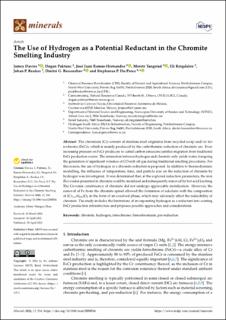| dc.contributor.author | Davies, Jamey | |
| dc.contributor.author | Paktunc, Dogan | |
| dc.contributor.author | Ramos-Hernandez, José Juan | |
| dc.contributor.author | Tangstad, Merete | |
| dc.contributor.author | Ringdalen, Eli | |
| dc.contributor.author | Beukes, Johan P. | |
| dc.contributor.author | Bessarabov, Dmitri G. | |
| dc.contributor.author | Du Preez, Stephanus P. | |
| dc.date.accessioned | 2022-10-25T06:44:09Z | |
| dc.date.available | 2022-10-25T06:44:09Z | |
| dc.date.created | 2022-05-11T14:04:53Z | |
| dc.date.issued | 2022 | |
| dc.identifier.citation | Minerals. 2022, 12 (5), 1-24. | en_US |
| dc.identifier.issn | 2075-163X | |
| dc.identifier.uri | https://hdl.handle.net/11250/3028072 | |
| dc.description.abstract | The chromium (Cr) content of stainless steel originates from recycled scrap and/or ferrochrome (FeCr), which is mainly produced by the carbothermic reduction of chromite ore. Ever-increasing pressure on FeCr producers to curtail carbon emissions justifies migration from traditional FeCr production routes. The interaction between hydrogen and chromite only yields water, foregoing the generation of significant volumes of CO-rich off-gas during traditional smelting procedures. For this reason, the use of hydrogen as a chromite reductant is proposed. In addition to thermodynamic modelling, the influence of temperature, time, and particle size on the reduction of chromite by hydrogen was investigated. It was determined that, at the explored reduction parameters, the iron (Fe)-oxides presented in chromite could be metalized and subsequently removed by hot-acid leaching. The Cr-oxide constituency of chromite did not undergo appreciable metalization. However, the removal of Fe from the chromite spinel allowed the formation of eskolaite with the composition of (Cr1.4Al0.6)O3 in the form of an exsolved phase, which may adversely affect the reducibility of chromite. The study includes the limitations of incorporating hydrogen as a reductant into existing FeCr production infrastructure and proposes possible approaches and considerations. | en_US |
| dc.language.iso | eng | en_US |
| dc.publisher | MDPI | en_US |
| dc.rights | Navngivelse 4.0 Internasjonal | * |
| dc.rights.uri | http://creativecommons.org/licenses/by/4.0/deed.no | * |
| dc.subject | pre-reduction | en_US |
| dc.subject | ferrochrome/ferrochromium | en_US |
| dc.subject | hydrogen | en_US |
| dc.subject | chromite | en_US |
| dc.title | The use of hydrogen as a potential reductant in the chromite smelting industry | en_US |
| dc.title.alternative | The use of hydrogen as a potential reductant in the chromite smelting industry | en_US |
| dc.type | Peer reviewed | en_US |
| dc.type | Journal article | en_US |
| dc.description.version | publishedVersion | en_US |
| dc.rights.holder | Copyright: © 2022 by the authors. Licensee MDPI, Basel, Switzerland. This article is an open access article distributed under the terms and conditions of the Creative Commons Attribution (CC BY) license (https:// creativecommons.org/licenses/by/ 4.0/). | en_US |
| dc.source.pagenumber | 1-24 | en_US |
| dc.source.volume | 12 | en_US |
| dc.source.journal | Minerals | en_US |
| dc.source.issue | 5 | en_US |
| dc.identifier.doi | 10.3390/min12050534 | |
| dc.identifier.cristin | 2023622 | |
| dc.relation.project | Norges forskningsråd: 309475 | en_US |
| cristin.ispublished | true | |
| cristin.fulltext | original | |
| cristin.qualitycode | 1 | |

